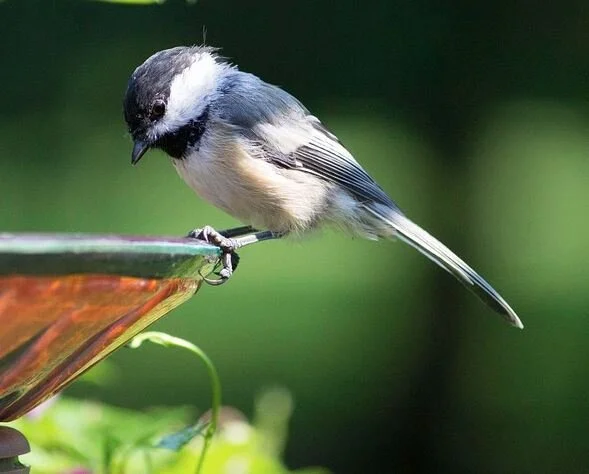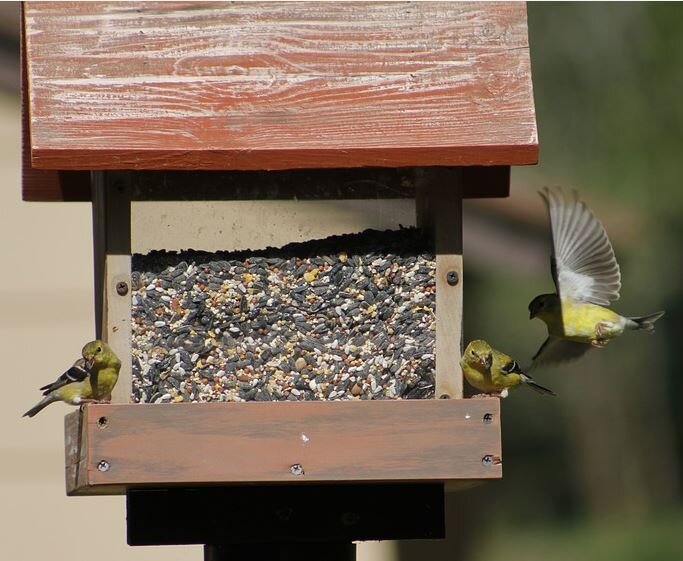Winter is a tough time for backyard birds. It’s important to provide food, water, and shelter to our feathered friends returning to their spring and summer homes. It’s as easy and fun as hanging a single bird feeder outside in your backyard and filling it with birdseed. If you haven’t considered backyard bird-watching or are just getting started, it’s certainly a fun and relaxing experience.
Here at Swansons, we love our feathered friends and would like to share a few tips to help you be successful with your bird-feeding adventure throughout the year. We will talk about some bird feeder styles, where to place your feeder, the importance of cleaning, types of birdseed, and access to water. We will also offer some great resources for further reading.
Bird Feeders
Before rushing to buy birdseed, it’s important to think about the type of feeder you would like to use. Even though there is no right or wrong, it can be helpful to know about some basic styles and designs.
Hopper Style Feeder
Hopper feeders can be made of wood, plastic, or metal with a chamber that holds the birdseed and a lid that lifts for easy filling. These feeders use gravity to keep the tray full, although depending upon the popularity of the feeder, it may need to be refilled often. Larger size seed or mixes are ideal for the hopper feeders since the tray opening is able to accommodate larger birds. This style is popular with many species including Finches, Grosbeaks, Sparrows, Jays, and Chickadees and can be mounted on a pole or for hanging.
Tube Style Feeder
Tube feeders are long slender containers with multiple perches and these feeders can either have smaller openings for thistle seed or larger openings for sunflower or blended mixes. This style of feeder is ideal for smaller birds such as Goldfinches, Sparrows, and Juncos. Some tube feeders have a wire cage surrounding the feeder to prevent larger birds or determined squirrels from getting through. Depending upon the style of tube feeder, there may or may not be protective cover above the feeder to keep the seed dry. If there isn’t a protective top, it may be a good idea to buy a rain guard since bird seed can mold quickly if not protected from the rain.
Suet Cage
Suet cages are the most popular type of feeder for holding suet, a solid brick of fat and birdseed. Cages are typically made of coated wire for strength and easy cleaning. Cages can hang independently or be attached to other feeders. Many suet cages include tail props for woodpeckers or other clinging birds. Covers are also popular to protect the suet from the elements.
Feeder Placement
The next step in your backyard feeding adventure is finding good location to place the feeders. It’s important to keep feeders away from windows to prevent any accidental collisions. Different species of birds prefer feeding at different levels so it’s helpful to locate feeders at various heights. Bird feeders located higher off the ground are popular hang-outs for many species including Jays, Sparrows, Grosbeaks, and Flickers. Hanging feeders closer to the ground, (but out of reach of cats) can attract Juncos, Titmice, Finches, Sparrows, and Chickadees.
Tips for Feeder Cleaning & Maintenance
Now that you’ve chosen your style of bird feeders, it’s helpful to know about general cleaning and maintenance. Just as we prefer to eat from clean plates, birds also appreciate eating from clean feeders. Cleaning bird feeders is important to help the feeders last longer and reduce the risk of spreading illness or disease.
In general, it’s recommended to clean feeders about once every 1 to 2 weeks, more often in wet weather since birdseed can mold quickly. If you see mold or seed debris in your feeder, remove all the birdseed and soak the feeder in a hot water bath with mild soap to loosen any caked-on debris. Disinfect with a diluted bleach solution (10 parts water to 1 part bleach) and allow to air dry. Cleaning also includes removing any extra seed waste and moldy food from the ground beneath the feeder. A build-up of seed waste may attract unwanted visitors to your backyard. The more birds who visit means more mess to clean, but it’s important to give your birds clean feeders and ground to eat from.
Bird Seed
What’s important to both birds and people? Food! Fruit and insects aren’t available during the winter months, so birds depend upon seeds as a food source. It’s important to feed birds the right food: seeds that have a high fat or oil content provide birds with energy needed to survive.
But how to know which type of seed to buy? If you visit a bird shop or any store selling bird supplies, there are shelves filled with different types of birdseed blends. An important part of backyard bird feeding is offering a variety of seed since different species have their own preferences. Birdseed can be found with one type of seed or as a blended mix. At Swansons, we carry a brand called Cole’s, which we have found to be popular with our feathered friends.
Are you interested in attracting Woodpeckers, Flickers, Finches and other songbirds? Then fill up your feeders with the “Special Feeder” blend, full of high energy sunflowers and peanuts. How about a trail mix for your birds? The “Nutberry Suet” mix with sunflowers, peanuts, dried cranberries, and apples will satisfy the appetite of jays, grosbeaks, sparrows, Juncos, and others!
Another food to offer is suet. Suet is high in fat, which birds need for winter, and suet cakes can be easily served in a suet cage. Many different birds will flock to your backyard if you’re offering some tasty suet!
Once you’ve picked out your bird food, it’s a good idea to store it in a cool, dry location in containers with secure lids to protect from squirrels and mice.
Unexpected Visitors
How many of you have experienced this personally, heard from friends, or seen entertaining videos of squirrels working terribly hard to eat birdseed? While the seed is clearly meant for the birds, other critters will find out you’re offering a free meal. There are a few blends of birdseed that may help encourage your party crashers to eat elsewhere such as Cole’s “Hot Meats” and “Blazing Hot” birdseed. These blends are infused with very hot chilies, which the birds enjoy, but it’s a bit too spicy for the squirrels. Songbirds such as finches, sparrows, and wrens are fans of the spicy feast!
Water
Another part of a successful backyard bird operation is providing water for your visitors. This can be as extensive as a fountain or as simple as a birdbath. Just be sure to clean the fixture and add fresh water frequently. Stale water isn’t as appealing as fresh water.
It can take a while…a few days, even a few weeks…before birds realize there is a free meal waiting for them in your yard. But once they do, you are in for a fun, entertaining, and rewarding experience.
For more bird advice, visit us in person, ask us questions on social media using #heyswansons, or check out these useful resources!
Washington Department of Fish & Wildlife: Backyard Wildlife Sanctuary
National Wildlife Federation: Garden for Wildlife
Wild Birds Unlimited Bird Feeding Basics









